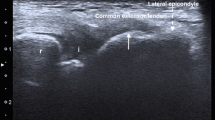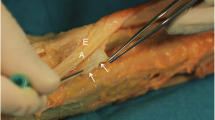Abstract
Purpose
To compare the six-month outcome of three different ultrasound-guided treatments for de Quervain’s disease (DQD).
Methods
We prospectively treated 75 consecutive patients (51 females, 24 males, mean age±standard deviation = 45.3 ± 9.8 years) with DQD. Patients’ features (hand dominance, intraretinaculum septum, accessory tendons) were recorded. Visual analogue scale (VAS), reduced disability (quickDASH) score, and retinaculum thickness were evaluated at baseline and after one (excluding retinaculum thickness), three, and six months. Patients were randomized into three groups of 25 patients each treated under ultrasound guidance: Group A (1 ml methylprednisolone acetate; mean baseline thickness = 1.6 mm; mean baseline VAS = 6; mean baseline quickDASH = 55); Group B (1 ml methylprednisolone acetate +15-day delayed 2 ml saline 0.9 %; 1.4; 6; 56); Group C (1 ml methylprednisolone acetate +15-day delayed 2 ml low molecular weight hyaluronic acid; 1.7; 6; 55).
Results
After one month results were: Group A mean VAS = 2; mean quickDASH = 23; Group B 2; 22; Group C 2; 21. After three months results were: Group A retinaculum thickness = 0.7 mm; 3; 27); Group B 0.8 mm; 1; 25; Group C 0.5 mm; 1; 23. After six months results were: Group A 1.5 mm; 3; 51; Group B 1 mm; 2; 51; Group C 0.7 mm; 1; 26 (P < 0.001 for all vs. baseline). Patients’ age, sex, hand dominance, presence of subcompartment dividing septum, and supernumerary tendons had no influence on outcome (P ≥ 0.177).
Conclusion
Addition of hyaluronic acid to ultrasound-guided injections of steroids to treat DQD seems to improve the outcome and to reduce the recurrence rate.
Key Points
• Ultrasound guidance allows for safe injection procedures to treat de Quervains’ disease
• Steroid injections allow prompt recovery in de Quervain’s disease with short-term recurrence
• Addition of hyaluronic acid allows recurrence rate reduction compared to simple steroid injections



Similar content being viewed by others
References
Keon-Cohen B (1951) De Quervain’s disease. J Bone Joint Surg 33B:96–99
Teh J, Vlychou M (2009) Ultrasound-guided interventional procedures of the wrist and hand. Eur Radiol 19:1002–1010
McDermott JD, Ilyas AM, Nazarian LN, Leinberry CF (2012) Ultrasound-guided Injections for de Quervain’s Tenosynovitis. Clin Orthop Relat Res 470:1925–1931
Ilyas AM, Ast M, Schaffer AA, Thoder J (2007) De quervain tenosynovitis of the wrist. JAAOS 15(12):757–764
Witt J, Pess G, Gelberman RH (1991) Treatment of de Quervain tenosynovitis: a prospective study of the results of injection of steroids and immobilization in a splint. J Bone Joint Surg Am 73:219–222
Vuillemin V, Guerini H, Morvan G (2012) Musculoskeletal interventional ultrasonography: The upper limb. Diagn Int Imaging 93:665–673
Orlandi D, Corazza A, Silvestri E, Serafini G, Savarino EV, Garlaschi G, Mauri G, Cimmino MA, Sconfienza LM (2014) Ultrasound-guided procedures around the wrist and hand: How to do. Eur J Radiol 83(7):1231–1238
Huisstede BMA, Coert JH, Fridén J, Hoogvliet P (2014) The European HANDGUIDE Group Consensus on a multidisciplinary treatment guideline for De Quervain disease: results from the European HANDGUIDE Study. Phys Ther. doi:10.2522/ptj.20130069
Lane LB, Boretz RS, Stuchin SA (2001) Treatment of de Quervain’s disease: role of conservative management. J Hand Surg (Br) 26(3):258–260
Jeyapalan K, Choudhary S (2009) Ultrasound-guided injection of triamcinolone and bupivacaine in the management of de Quervain′s disease. Skelet Radiol 38:1099–1103
Peters-Veluthamaningal C, van der Windt DA, Winters JC, Meyboom-de Jong B (2009) Corticosteroid injection for trigger finger in adults. Cochrane Database Syst Rev 21(1):CD005617
Kume K, Amano K, Yamada S, Amano K, Kuwaba N, Ohta H (2012) In de Quervain's with a separate EPB compartment, ultrasound-guided steroid injection is more effective than a clinical injection technique: a prospective open-label study. J Hand Surg Eur 37:523
Harvey FJ, Harvey PM, Horsley MW (1990) De Quervain’s disease:surgical or nonsurgical treatment. J Hand Surg [Am] 15:83–87
Ishijima M, Nakamura T, Shimizu K, Hayashi K, Kikuchi H, Soen S et al (2014) Intra-articular hyaluronic acid injection versus oral non-steroidal anti-inflammatory drug for the treatment of knee osteoarthritis: a multi-center, randomized, open-label, non-inferiority trial. Arthritis Res Ther 16(1):R18
Tagliafico A, Serafini G, Sconfienza LM, Lacelli F, Perrone N, Succio G et al (2011) Ultrasound-guided viscosupplementation of subacromial space in elderly patients with cuff tear arthropathy using a high weight hyaluronic acid: prospective open-label non-randomized trial. Eur Radiol 21(1):182–187
Tormenta S, Sconfienza LM, Iannessi F, Bizzi E, Massafra U, Orlandi D et al (2012) Prevalence study of iliopsoas bursitis in a cohort of 860 patients affected by symptomatic hip osteoarthritis. Ultrasound Med Biol 38(8):1352–1356
Callegari L, Spano’ E, Bini A, Valli F, Genovese E, Fugazzola C (2011) Ultrasound-Guided Injection of a Corticosteroid and Hyaluronic Acid. A Potential New Approach to the Treatment of Trigger Finger. Drugs 11(2):137–145
Riccio M, Battiston B, Pajardi G, Corradi M, Passaretti U, Atzei A et al (2010) Study Group on Tendon Adhesion of Italian Society of Hand Surgery. Efficiency of Hyaloglide in the prevention of the recurrence of adhesions after tenolysis of flexor tendons in zone II: a randomized, controlled, multicentre clinical trial. J Hand Surg Eur 35(2):130–138
Sconfienza LM, Bandirali M, Serafini G, Lacelli F, Aliprandi A, Di Leo G et al (2012) Rotator cuff calcific tendinitis: does warm saline solution improve the short-term outcome of double-needle US-guided treatment? Radiology 262(2):560–566
Sconfienza LM, Viganò S, Martini C, Aliprandi A, Randelli P, Serafini G et al (2013) Double-needle ultrasound-guided percutaneous treatment of rotator cuff calcific tendinitis: tips & tricks. Skelet Radiol 42(1):19–24
Peck E, Ely E (2013) Successful treatment of de Quervain tenosynovitis with ultrasound-guided percutaneous needle tenotomy and platelet-rich plasma injection: a case presentation. PMR 5(5):438–441
Moore JS (1997) De Quervain’s tenosynovitis. Stenosing tenosynovitis of the first dorsal compartment. J Occup Environ Med 39:990–1002
Mitsui Y, Gotoh M, Nakama K, Yamada T, Higuchi F, Nagata K (2008) Hyaluronic acid inhibits mRNA expression of proinflammatory cytokines and cyclooxygenase-2/prostaglandin E(2) production via CD44 in interleukin-1-stimulated subacromial synovial fibroblasts from patients with rotator cuff disease. J Orthop Res 26:1032–1037
Wiebkin OW, Muir H (1975) Influence of the cells on the peri- cellular environment: the effect of hyaluronic acid on proteoglycan synthesis and secretion by chondrocytes of adult cartilage. Philos Trans R Soc Lond B Biol Sci 271(912):283–291
Wiig M, Abrahamsson SO (2000) Hyaluronic acid modulates cell proliferation unequally in intrasynovial and extra- synovial rabbit tendons in vitro. J Hand Surg (Br) 25(2):183–187
Sawaizumi T, Nanno M, Ito H (2007) De Quervain’s disease: efficacy of intra-sheath triamcinolone injection. Int Orthop 31(2):265–268
Ashraf MO, Devadoss VG (2014) Devadoss Systematic review and meta-analysis on steroid injection therapy for de Quervain’s tenosynovitis in adults. Eur J Orthop Surg Traumatol 24:149–157
Tuncay I, Ozbek H, Atik B, Ozen S, Akpinar F (2002) Effects of hyaluronic acid on postoperative adhesion of tendo calcaneus surgery: an experimental study in rats. J Foot Ankle Surg 41(2):104–108
Acknowledgments
The scientific guarantor of this publication is Dr. Enzo Silvestri. The authors of this manuscript declare no relationships with any companies whose products or services may be related to the subject matter of the article. This study has received funding from the Young Researchers Grant awarded by the European Society of Musculoskeletal Radiology. One of the authors has significant statistical expertise. Institutional Review Board approval was obtained. Written informed consent was obtained from all subjects (patients) in this study. Methodology: prospective, randomised, controlled, multicentrr study.
Author information
Authors and Affiliations
Corresponding author
Rights and permissions
About this article
Cite this article
Orlandi, D., Corazza, A., Fabbro, E. et al. Ultrasound-guided percutaneous injection to treat de Quervain’s disease using three different techniques: a randomized controlled trial. Eur Radiol 25, 1512–1519 (2015). https://doi.org/10.1007/s00330-014-3515-0
Received:
Revised:
Accepted:
Published:
Issue Date:
DOI: https://doi.org/10.1007/s00330-014-3515-0




